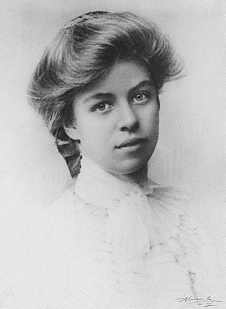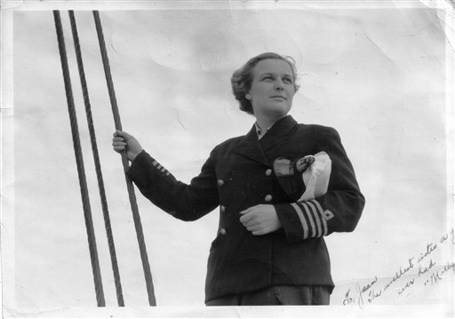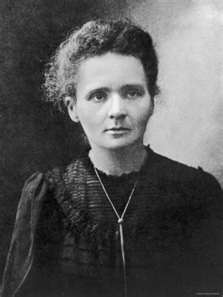
In the late 19th century after universities began admitting women, there were still challenges to overcome. Most secondary schools for girls focused on social graces and being a good conversationalist but didn’t prepare them for entrance to the university. When Gerty Radnitz at 16 decided that she wanted to go to medical school, she was completely unprepared. She overcame this disadvantage to become the first woman to win a Nobel Prize in Physiology and Medicine and the first American woman to win a Nobel Prize.
Gerty Theresa Radnitz was born August 15, 1896, in Prague which was then part of the Austro-Hungarian Empire. Her family was Jewish and moderately well off. Her father, Otto Radnitz, was a chemist who invented a method for refining sugar and managed several beet sugar refineries. The oldest of three girls, Gerty was tutored at home until the age of ten when she went to finishing school. Recognizing her talent, her uncle who was a physician encouraged her to go to medical school. With the help of family and tutors, over the next two years she accumulated the equivalent of 5 – 6 years study in Latin, mathematics, physics, and chemistry in preparation to take her entrance exams. She passed and at 18 enrolled at the German branch of the Charles Ferdinand University at Prague.
During her first year of university, Gerty discovered two things that changed her life: biochemistry and Carl Cori. Carl was the son of Carl Cori, a physician, and Martha Lippich. His father went on to get a doctorate in zoology and do research at the Marine Biological Station in Trieste where he was the director. He often took the younger Carl with him on field expeditions to do research and gather specimens. Trieste, in what is now northern Italy, was a diverse area where Carl was exposed to people of different backgrounds and developed what he called “immunity to racial propaganda.” The fact that Gerty was Jewish and he was Catholic didn’t bother him at all, but it would play a role later in their lives.
 For two years they studied together and enjoyed taking trips for hiking or skiing, until in 1916, Carl was drafted into the Austrian army. In 1918, assigned to a field hospital for infectious disease, he saw first hand the effect of disease on the troops, as well as the impact of the Influenza pandemic sweeping the world. The Cori family had a history of scholarship, with a number of professors on both sides of the family. This combined with his sense of helplessness in the face of disease contributed to his desire to do research. Once the war was over, Carl and Gerty were reunited and received their medical degrees in 1920. They also published their first joint paper, beginning a collaboration that would last for their entire careers.
For two years they studied together and enjoyed taking trips for hiking or skiing, until in 1916, Carl was drafted into the Austrian army. In 1918, assigned to a field hospital for infectious disease, he saw first hand the effect of disease on the troops, as well as the impact of the Influenza pandemic sweeping the world. The Cori family had a history of scholarship, with a number of professors on both sides of the family. This combined with his sense of helplessness in the face of disease contributed to his desire to do research. Once the war was over, Carl and Gerty were reunited and received their medical degrees in 1920. They also published their first joint paper, beginning a collaboration that would last for their entire careers.
After receiving their degrees, they traveled to Vienna where they were married, and Carl and Gerty were both able to obtain positions doing post-doctoral research. The post war years were difficult. Research was a low priority and supplies were hard to obtain. Carl was one of the few able to do research, because his father sent him a bag of frogs. Gerty worked in pediatrics doing research on thyroid and blood disorders. The conditions were poor, however. She worked only for meals which were not very nutritious, causing her to develop a vitamin A deficiency. The fact that Gerty was a woman and Jewish, even though she had converted to Catholicism when she married made finding a position very difficult. Carl became even more uneasy about the situation in Europe when he was required to prove his Aryan ancestry for a position at Graz. They began considering moving to the United States.

After working in different cities, Carl in Graz and Gerty in Vienna, any position would only be acceptable to Carl if he could obtain a position for Gerty as well. Carl and Gerty Cori were ideally suited as research partners. William Daughaday of Washington University School of Medicine said “Carl was the visionary. Gerty was the lab genius.” In personality, they were the reverse of Irene and Frederic Joliot-Curie. Carl was somewhat shy, relaxed, and a slower more contemplative thinker. Gerty was outgoing, vivacious, and a brilliant quick thinker. She was also more ambitious than Carl and more demanding in the lab.
Finally, in 1922, Carl obtained a position at the Institute for the Study of Malignant Disease (later renamed the Roswell Park Memorial Institute), in Buffalo, New York. Gerty was given a position as an assistant pathologist. Although they worked in different labs, they continued the practice of publishing papers together, even though Gerty was told more than once to stay out of Carl’s lab. Eventually, the benefit of allowing them to work together was acknowledged and the breach in protocol was overlooked. During their time in Buffalo from 1922 to 1931, Carl and Gerty established their reputations and became US citizens.
Gerty and Carl were primarily interested in studying insulin and the production of energy in the body. If you remember your high school biology, the Cori cycle explains how the body breaks down glycogen into glucose for use in muscles and converts lactic acid back into glycogen for storage in the liver. The discovery and explanation of this process in 1929 would be the basis for their Nobel Prize in 1947. This research, however, wasn’t a good fit for the work being done at the Institute, which was primarily focused on cancer research, so together the Cori’s began looking for other positions.
In spite of the fact that Gerty had published frequently, individually in addition to jointly with Carl, he began to receive job offers, not Gerty. Most of these offers, including those from Cornell and the University of Toronto, did not include a possibility for positions for her. At the University of Rochester, Carl was offered a position under the condition that he stop collaborating with his wife. Gerty was even taken aside and told that she was hindering his career because it was “un-American” for a husband and wife to work together. In fact it was very common for women to work in conjunction with their husbands during this time, although it was usually as low or unpaid “assistants” meaning that the wife rarely received recognition for her contribution. This was unacceptable to both Carl and Gerty.
Finally in 1931, they received job offers from the Washington University medical school in St. Louis. Even though Carl became the chairman of the pharmacology department, Gerty was only offered a position as a research associate at one-fifth the pay. Still they were able to collaborate and would remain at Washington University for the remainder of their careers doing groundbreaking research in glycogen utilization and with enzymes. During World War II, the demand for women scientists increased due to the reduced work force and Gerty finally became a full professor.

Copyright © Becker Medical Library, Washington University School of Medicine
Gerty and Carl were supportive of other scientists as well, hiring women and Jews when other universities and even other departments at Washington refused to do so. Eventually, the work done in their lab resulted in eight Nobel Prizes, including a joint prize for Carl and Gerty in Physiology and Medicine. Over time, Carl became more involved in writing, directing research of students, and administration, and running the lab became exclusively Gerty’s domain. As with many passionate people, she was not always liked or easy to work for. She demanded precision. The work and the results demanded it.
Both of the Coris impressed others with their depth of knowledge about a wide range of topics. For most of her time at Washington, Gerty had 5 – 7 books delivered weekly to her from a local lending library. Every Friday she would prepare her list for the next week. She loved history and biography, while Carl was a poet and read archeology and art. She was the one who constantly read journal articles and kept people in the lab up-to-date on new findings in biology and related fields.
The Coris worked hard, but also tried to leave work at the lab. They entertained, kept a garden, and continued enjoying the outdoors. It was on a mountain climbing trip in 1947 that Gerty first fell ill and they discovered she had a disease that would eventually take her life. Her bone marrow was no longer producing red blood cells. She worked almost to the end. Her only concessions to the disease were taking time out for the blood transfusions that were necessary, and setting up a cot in her office where she would lie down to do her reading. Gerty Cori died at her home on October 26, 1957.
Resources
Nobel Prize Women in Science by Sharon Bertsch McGrayne
American Chemical Society National Historic Chemical Landmark
Read about other Famous Women in Math and Science





































